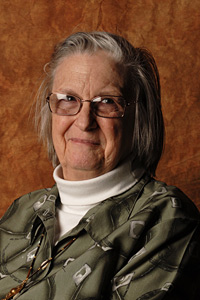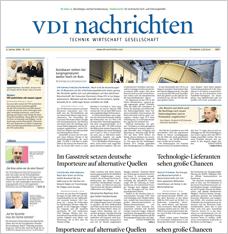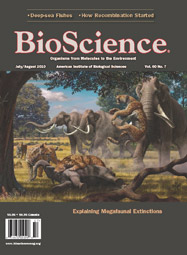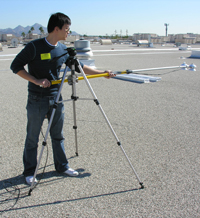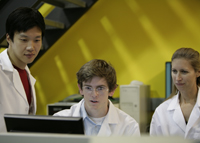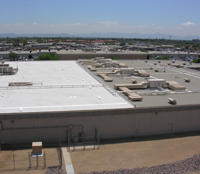Q&A with Elinor Ostrom
Dr. Ostrom (1933-2012) was a research professor at the School of Human Evolution and Social Change in the College of Liberal Arts and Sciences and was founding director of the Center for the Study of Institutional Diversity. In 2009, she was awarded the Nobel Prize in Economics for her work in economic governance, particularly as it applies to shared resources such as pastures, fisheries, and groundwater basins. Her research examined ways that institutions and users operating at widely different scales can work together to sustain such resources.
Arnim Wiek: Lin, thank you very much for agreeing to have a little interview here in the preparation of the International Conference on Sustainability Science in Rome in June. We have structured the conference along different streams, and I’d like to chat a little bit with you about three different challenges we try to address here.
Elinor Ostrom: Good. Good.
Arnim Wiek: The first one is – and all of them I have kind of selected to make it kind of relevant to also with what you’ve been working on in the field of sustainability science and governance issues. The first one is everybody knows you have been working very, very extensively on local governance issues – on the local level and getting a good sense for how people self-govern and self-organize.
Elinor Ostrom: May self-govern.
Arnim Wiek: “May,” yes exactly. May self-govern natural resources and the interactions between societal demand on the one hand side, and natural capacities on the other hand. My question is – we have one stream that is focusing on global governance.
Elinor Ostrom: Uh huh.
Arnim Wiek: The big question I think that is circulating in our field for many, many years is how do we use your insights from the more local/regional level for insights on the global level?
Elinor Ostrom: Well one of the big insights we have, going way back to our study of metropolitan governance and urban services, is that it is rare that there is just one level that is the level for everything. So, if we take metropolitan governance first, what we showed is that while there were some services better performed at a big metropolitan area, there were many others that were better performed at a smaller or medium. Vincent Ostrom and Charlie Tiebout and others developed the concept of polycentricity: multiple units at different scales that had developed – potentially, if it was a polycentric system – ways of working together, and that’s never perfect, but at least ways of doing so.
Well if you think about a polycentric approach to global warming, then I think we can start using some of the lessons. Some people don’t know about the earlier work, but the lessons of polycentricity are that if you can organize some things at very small and medium and large and find ways of getting them to relate, you could usually do a lot better. Global warming, I argue, has been misconceptualized. It’s been looked at as you, an individual, you produce something, and it goes oom! [pointing upward] only. Well, that’s wrong. So the pollutants that you –when you drive, your car is producing pollutants – some of them are local.
You’re finding that you have a lot of money being paid for gas. Well that’s family. Your health isn’t as good as it could be if you biked. That’s you, so individual, family, local. If we can find more ways of encouraging those things; not that you are going to solve – by solving some of the local and regional – are going to solve global, but it has an impact.
What we need to be doing is the innovative programs around the world that are working on it – and there are – understand how they work, enhance the probabilities others will do it. To some extent, we challenge our national leaders, “Okay you guys, there are ways of doing this and move on.” We need the global, but we just wait for it.
Arnim Wiek: Right, right, right.
Elinor Ostrom: Bad.
Arnim Wiek: Yeah, don’t wait.
Elinor Ostrom: Don’t wait, move and then push to get the global as well.
Arnim Wiek: Yeah and this is on the – this is on the causing side as well as the effect side right? I mean when we play out and say, “How does this actually impact on the local level?” It is again tangible and people can relate to it.
Elinor Ostrom: Yeah. They found, for example, they’ve done a recent study on the impact of metropolitan pollution efforts in metropolitan areas where they have substantially reduced pollutants. Some of the life long – the average expected life is two to three years more. Well, that’s a fairly substantial thing for a big population.
Arnim Wiek: Yeah. Yeah.
Elinor Ostrom: So that also reduced global problems, but so it’s how we think of it differently.
Arnim Wiek: Right. Excellent. The second stream we are concerned about, I think not only in this conference, but also in our emerging field of sustainability science is that we have defined this field already a decade ago as a strong problem-oriented field. So we are concerned about how do we address problems? The point is that there is quite some debate about that we are getting better and better in understanding and analyzing these problems.
The question is: at the same time sustainability science is encouraged to make a strong contribution to the solution of the problems, how do we bridge this gap between getting very, very rigorous understanding of the problems to actually creating strong solutions for these problems? Some might argue this is not really in the domain of science of any longer. This needs to be then policy domain, but some might argue well this is actually still in the science domain.
Elinor Ostrom: If they’re not linked, we’re in trouble and so part of our problem is how we link science and policy. So, not all policy scientists are going to do all of the hard work on the biophysical side and vice versa, but if we don’t develop communities that can communicate with one another, then we don’t make anything other than progress on one. And I will argue that you won’t have progress on the policy if they don’t understand the problem.
Further, we won’t make much progress if we think there’s a single solution, and so part of our problem is how do we study a variety of efforts that were successful or failed.
Arnim Wiek: Right.
Elinor Ostrom: Failures are very important to study because what we may find that successes have eight variables and failures have six of the eight but not two.
Arnim Wiek: Yes.
Elinor Ostrom: We are dealing with complex problems and complex solutions, and we need to understand the complexity of both.
Arnim Wiek: We have another stream in our conference. It’s focusing on education for sustainability. We have a PhD seminar and special stream on sustainability and education. The question that is kind of circulating in our field is how can we teach a field that is still in development? What are kind of the critical challenges we need to overcome in order to strengthen our field and to develop a strong position our students can gain from?
Elinor Ostrom: Well, partly, you need both to be training students in the diverse sciences, and no one student should learn everything. But then what are the fora for discussions where there’s respect across disciplines and getting that community – that’s a sense of community that we’re struggling with issues that people who are just disciplinary aren’t. In order to do that, we’re going to have to learn a little bit more about some of these questions. Right now I have some of my students really looking into GIS and remote sensing because I think being able to do over time and spatial and temporal in the same analysis is very powerful for us.
This is very technical, so not all of my students need to do this or are interested. They’ve got to be fascinated; but around our seminar tables, we’ve discussed some of the assets of GIS and remote sensing enough that people are beginning to understand some of the lessons that they can learn. They don’t have to do it themselves, but they’ve got to respect what they can get from that form of analysis: and that is, it takes a while just to develop that but that’s the kind of community you need to be developing. We need all of us.
Arnim Wiek: Yes. Absolutely. Absolutely. Great. Thank you very much Lin for sharing some of your thoughts related to this conference with us.
Elinor Ostrom: I wish I could join you for it, but – [Laughing]
Arnim Wiek: Next time.
Elinor Ostrom: Yes, that would be nice.
July 30, 2010


